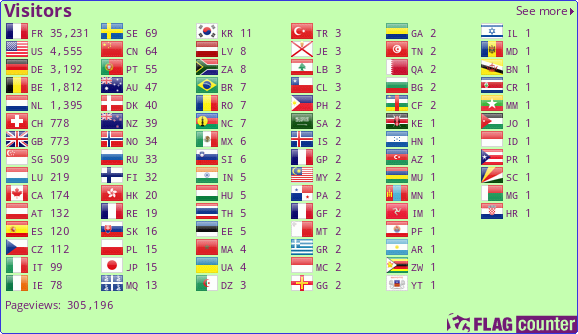Pour completer la série des earthcaches de Trégastel,
voici Filons de Trégastel
Cette géocache est une earthcache, il n'y a donc pas de boite contenant un logbook. Pour valider cette earthcache, vous devez répondre aux questions ci dessous, m'envoyez vos réponses par message géocaching en indiquant GC73PEH . Puis loguez votre found it et je vous contacterai en cas de probléme ...
Cette géocache vous invite devant des formes impressionnantes de granite rose à Trégastel. Elle nécessite de se rendre sur le waypoint qui est fréquemment recouvert par la marée, soyez donc vigilant et ne négligez ni horaires ni coéfficients !
De nombreuses Formes surprenantes ont vu le jour sur le massif granitique local suite à des évènements géologiques de plus de 300 millions d'années sous la croûte continentale. Sur le rendez vous du waypoint, vous pourrez observer un grand filon surgit du granite rose. Le granite est constitué de 3 minéraux : le quartz plutot blanc, le mica plutot noir et le feldspath principalement rose. Le filon principale semble filer dans la mer malgré les cassures des blocs de granite rose, alors qu'un petit filon perpendiculaire semble jaillir de coté.
Les phénocristaux pluricentimétriques de feldspath potassique rose sont statistiquement disposés parallèlement les uns aux autres dessinant une structure de flux magmatique grossièrement orientée est-ouest, acquise lors de la mise en place du pluton. De nombreuses enclaves d’une roche noire à grain fin, basique, parfois regroupées en véritables essaims, sont réparties au sein de ce granite. Elles proviennent de la dilacération de masses basiques et sont accompagnées de filons de même origine qui semblent se perdre dans le magma granitique.
Le filon d’aplite de couleur rose clair est issu du granite intermédiaire. Il recoupe à l'emporte-pièce le granite rose dans lequel il peut même découper des enclaves anguleuses de petite dimension, signifiant par là qu'il a pénétré dans un matériau totalement cristallisé et refroidi quand le granite à grain fin et son cortège filonien se sont mis en place. (Extrait de : Joyau géologique du Trégor, le magmatisme composite du complexe granitique de Ploumanac’h, Côtes-d’Armor, France,par Jean Plaine )
La mer recouvrant ces strates, des crustacés s'aglutinent sur les formes protubérantes du granite pour filtrer l'eau de mer, ce sont des balanes.

Question 1 : De quelle couleur est le filon A et de quel phénomène provient-il ?
Question 2 : De quelle couleur est le filon B et comment s'est-il formé ?
 Bon Géocaching
Bon Géocaching 
--------------------------------Traduit par google du francais à l'anglais-------------------------------
To complete the series of earthcaches of Trégastel,
Here is Filons de Trégastel
This geocache is an earthcache, so there is no box containing a logbook. To validate this earthcache, you must answer the questions below, send me your answers by geocaching message indicating GC73PEH. Then log your found it and I will contact you in case of problem ...
This geocache invites you to impressive forms of pink granite in Trégastel. It requires to go to the waypoint which is often covered by the tide, so be vigilant and do not neglect neither schedules nor coefficients!
Many surprising shapes have emerged on the local granite massif following geological events of more than 300 million years under the continental crust. On the rendezvous of the waypoint, you can observe a large vein rising from the pink granite. The granite is made up of 3 minerals: quartz rather white, mica rather black and feldspar mainly pink. The main vein seems to be spinning in the sea despite the breaks of the blocks of pink granite, while a small perpendicular vein seems to gush aside.
The pluricentimetric phenocrysts of pink potassium feldspar are statistically arranged parallel to each other, drawing a roughly oriented east-west magmatic flux structure acquired during the placement of the pluton. Numerous enclaves of a fine-grained, basic rock, sometimes grouped together as real swarms, are distributed within this granite. They originate from the dilaceration of basic masses and are accompanied by veins of the same origin which seem to be lost in the granite magma.
The light pink aplite vein is derived from the intermediate granite. He punched out the pink granite in which he could even cut angular enclaves of small size, meaning that he had penetrated a totally crystallized and cooled material when the fine-grained granite and its vein cortege are placed. (Extract from: Geological jewel of Trégor, the composite magmatism of the granite complex of Ploumanac'h, Côtes-d'Armor, France, by Jean Plaine)
The sea covering these strata, the crustaceans mingle on the protuberant forms of the granite to filter the sea water, they are balanes.

Question 1: What color is the lode A and what is the phenomenon ?
Question 2: What color is the B vein and how was it formed ?
 Good Géocaching
Good Géocaching 
